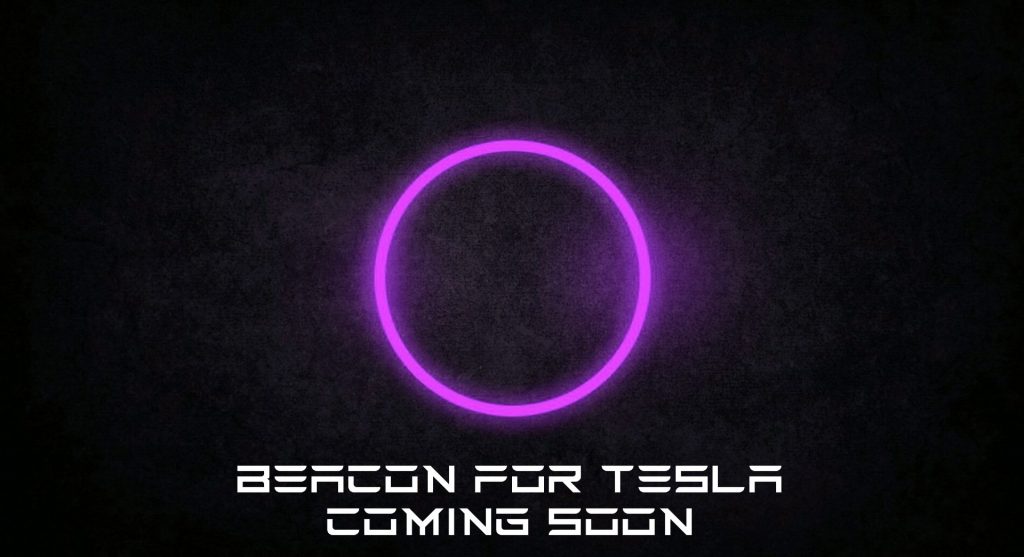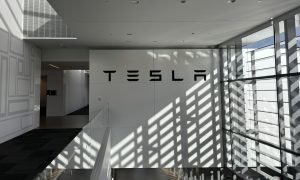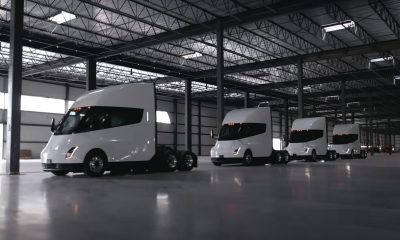As COVID-19 continues to spread throughout parts of the world, conference calls have become a staple in many people’s lives. In the midst of the pandemic last year, Elon Musk stated that video conferencing within a Tesla would “definitely [be] a future feature.” Well, Tesla Model S owner and Mass Luminosity CEO Angel Munoz decided that the future is now.
“Both my wife and I have Teslas. She drives a Model X and I drive a Model S. I just always thought what an incredible piece of real estate is right in the center there,” he told Teslarati. “You know, quite frankly, I’m not going to watch movies in my car, not going to play games in my car—and I’m a gamer. Not interested. But I will do a video conference.”
Munoz happens to be the co-creator of Beacon, a browser-based video and voice conferencing service. He did not initially plan to create Beacon for Tesla, but seemed enticed by the challenge of bringing the service to his car.
Munoz worked closely with Beacon’s Senior VP of Technology Teodor Atroshenko for almost a year to develop Beacon for Tesla. “It didn’t work in the beginning. It didn’t work at all. It took us a while,” he said.
The pair seemed to take a page right out of Elon Musk’s handbook while developing Beacon for Tesla, too. They appear to have gone all out, introducing features and specs to Beacon for Tesla, like 4K ultra high definition, 3D stereo audio, and the ability to transfer calls seamlessly from desktop to phone to Tesla’s infotainment system with a click of a button.
“Teodor and I, we took it as a personal challenge…And we didn’t have to reverse engineer anything,” he explained. “We just had to be aware of how [Tesla] restricts things. And then we created Beacon on the web in a way that it’s immediately accessible by being safe.”
In January 2021, Munoz and Atroshenko made a breakthrough and were able to successfully complete a video conference call in the CEO’s Model S. Beacon for Tesla uses the car’s mics, speakers, and video panel. However, they were not able to access Tesla’s in-cabin camera.
“So right now the way that we have it is that it syncs between the camera on your phone and the call. But we cannot access the [in-cabin] camera without permission,” Munoz stated.
Beacon is open to working with Tesla to bring the full power of its video and audio conferencing service to owners like Munoz himself. He told Teslarati that Beacon for Tesla beta has a tentative launch date set for mid-March 2021.

However, Tesla owners will still be able to use Beacon in their vehicles when it launches. Munoz explained that Tesla owners won’t have to download an app to use Beacon since it is optimized for Chromium browsers, the same engine used for Tesla browsers. So users would just have to log-in to access the service. He noted that Tesla actually saves cookies now so logging into accounts would be easier.
Munoz had one suggestion for Elon Musk about access to browser information in Teslas, though. If Munoz had the chance to talk to Musk he would say:
“Elon, keep that, but make it like you do other things on your Tesla. For example, if you’re going to open the glove compartment…you can make it that it pops a security code that you need to put in or if you want to open your car, you can make a security code. I have both, so do the same for the browser. So, the browser saves that, but before you launch the page, have that security code and then it launches the page. I would love to tell him [Elon] that’s the right way of going about that.”
The Age of the Autonomous Vehicles
Tesla has been dubbed by owners and some experts in the industry as not only the leading EV automaker, but the future leader of autonomous vehicles as well. As a long-time Tesla Model S owner, Munoz seems to understand the future Elon Musk envisions for Tesla with regards to autonomy and the Robotaxi fleet.
“Think about the possibilities. Imagine this. I have a Model 3, and let’s say that autonomous driving becomes a reality—obviously that’s still kinda up in the air,” he said.
“But let’s say that someone is being picked up in a Model 3, and something happens or something, I can call the car and [contact the passenger].” Munoz described other scenarios where an in-car Tesla video conference call would be useful as well.
His examples pointed out that autonomous vehicles would still need some sort of human interaction and communication between the car owner and the passenger. And if there’s anything the pandemic has taught us, it’s that conference calls are a good way to communicate and interact in the absence of physical presence.
The Teslarati team would appreciate hearing from you. If you have any tips, email us at tips@teslarati.com or reach out to me at maria@teslarati.com.
News
Tesla begins Robotaxi certification push in Arizona: report
Tesla seems serious about expanding its Robotaxi service to several states in the coming months.

Tesla has initiated discussions with Arizona transportation regulators to certify its driverless Robotaxi service in the state, as per a recent report from Bloomberg News. The move follows Tesla’s launch of its Robotaxi pilot program in Austin, Texas, as well as CEO Elon Musk’s recent comments about the service’s expansion in the Bay Area.
The Arizona Department of Transportation confirmed to Bloomberg that Tesla has reached out to begin the certification process for autonomous ride-sharing operations in the state. While details remain limited, the outreach suggests that Tesla is serious about expanding its driverless Robotaxi service to several territories in the coming months.
The Arizona development comes as Tesla prepares to expand its service area in Austin this weekend, as per CEO Elon Musk in a post on X. Musk also stated that Tesla is targeting the San Francisco Bay Area as its next major market, with a potential launch “in a month or two,” pending regulatory approvals.
Tesla first launched its autonomous ride-hailing program on June 22 in Austin with a small fleet of Model Y vehicles, accompanied by a Tesla employee in the passenger seat to monitor safety. While still classified as a test, Musk has said the program will expand to about 1,000 vehicles in the coming months. Tesla will later upgrade its Robotaxi fleet with the Cyercab, a two-seater that is designed without a steering wheel.
Sightings of Cybercab castings around the Giga Texas complex suggests that Tesla may be ramping the initial trial production of the self-driving two-seater. Tesla, for its part, has noted in the past that volume production of the Cybercab is expected to start sometime next year.
In California, Tesla has already applied for a transportation charter-party carrier permit from the state’s Public Utilities Commission. The company is reportedly taking a phased approach to operating in California, with the Robotaxi service starting with pre-arranged rides for employees in vehicles with safety drivers.
News
Tesla sets November 6 date for 2025 Annual Shareholder Meeting
The automaker announced the date on Thursday in a Form 8-K.

Tesla has scheduled its 2025 annual shareholder meeting for November 6, addressing investor concerns that the company was nearing a legal deadline to hold the event.
The automaker announced the date on Thursday in a Form 8-K submitted to the United States Securities and Exchange Commission (SEC). The company also listed a new proposal submission deadline of July 31 for items to be included in the proxy statement.
Tesla’s announcement followed calls from a group of 27 shareholders, including the leaders of large public pension funds, which urged Tesla’s board to formally set the meeting date, as noted in a report from The Wall Street Journal.
The group noted that under Texas law, where Tesla is now incorporated, companies must hold annual meetings within 13 months of the last one if requested by shareholders. Tesla’s previous annual shareholder meeting was held on June 13, 2024, which placed the July 13 deadline in focus.
Tesla originally stated in its 2024 annual report that it would file its proxy statement by the end of April. However, an amended filing on April 30 indicated that the Board of Directors had not yet finalized a meeting date, at least at the time.
The April filing also confirmed that Tesla’s board had formed a special committee to evaluate certain matters related to CEO Elon Musk’s compensation plan. Musk’s CEO performance award remains at the center of a lengthy legal dispute in Delaware, Tesla’s former state of incorporation.
Due to the aftermath of Musk’s legal dispute about his compensation plan in Delaware, he has not been paid for his work at Tesla for several years. Musk, for his part, has noted that he is more concerned about his voting stake in Tesla than his actual salary.
At last year’s annual meeting, TSLA shareholders voted to reapprove Elon Musk’s compensation plan and ratified Tesla’s decision to relocate its legal domicile from Delaware to Texas.
Elon Musk
Grok coming to Tesla vehicles next week “at the latest:” Elon Musk
Grok’s rollout to Tesla vehicles is expected to begin next week at the latest.

Elon Musk announced on Thursday that Grok, the large language model developed by his startup xAI, will soon be available in Tesla vehicles. Grok’s rollout to Tesla vehicles is expected to begin next week at the latest, further deepening the ties between the two Elon Musk-led companies.
Tesla–xAI synergy
Musk confirmed the news on X shortly after livestreaming the release of Grok 4, xAI’s latest large language model. “Grok is coming to Tesla vehicles very soon. Next week at the latest,” Musk wrote in a post on social media platform X.
During the livestream, Musk and several members of the xAI team highlighted several upgrades to Grok 4’s voice capabilities and performance metrics, positioning the LLM as competitive with top-tier models from OpenAI and Google.
The in-vehicle integration of Grok marks a new chapter in Tesla’s AI development. While Tesla has long relied on in-house systems for autonomous driving and energy optimization, Grok’s integration would introduce conversational AI directly into its vehicles’ user experience. This integration could potentially improve customer interaction inside Tesla vehicles.
xAI and Tesla’s collaborative footprint
Grok’s upcoming rollout to Tesla vehicles adds to a growing business relationship between Tesla and xAI. Earlier this year, Tesla disclosed that it generated $198.3 million in revenue from commercial, consulting, and support agreements with xAI, as noted in a report from Bloomberg News. A large portion of that amount, however, came from the sale of Megapack energy storage systems to the artificial intelligence startup.
In July 2023, Musk polled X users about whether Tesla should invest $5 billion in xAI. While no formal investment has been made so far, 68% of poll participants voted yes, and Musk has since stated that the idea would be discussed with Tesla’s board.
-

 Elon Musk1 week ago
Elon Musk1 week agoTesla investors will be shocked by Jim Cramer’s latest assessment
-

 Elon Musk20 hours ago
Elon Musk20 hours agoxAI launches Grok 4 with new $300/month SuperGrok Heavy subscription
-

 Elon Musk3 days ago
Elon Musk3 days agoElon Musk confirms Grok 4 launch on July 9 with livestream event
-

 News7 days ago
News7 days agoTesla Model 3 ranks as the safest new car in Europe for 2025, per Euro NCAP tests
-

 Elon Musk2 weeks ago
Elon Musk2 weeks agoA Tesla just delivered itself to a customer autonomously, Elon Musk confirms
-

 Elon Musk1 week ago
Elon Musk1 week agoxAI’s Memphis data center receives air permit despite community criticism
-

 Elon Musk2 weeks ago
Elon Musk2 weeks agoTesla’s Omead Afshar, known as Elon Musk’s right-hand man, leaves company: reports
-

 News2 weeks ago
News2 weeks agoXiaomi CEO congratulates Tesla on first FSD delivery: “We have to continue learning!”
















